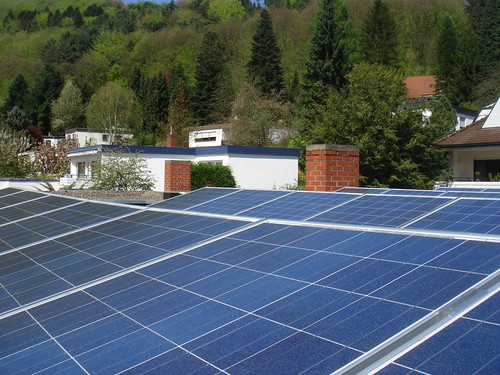At Ifa Berlin I talked to US journalists, bloggers and twitterers who were very interested in real life experiences with Germany´s renewable energy politics.
So here comes the homeowner´s perspective:

Foto: Steamtalks
The Schröder / Fischer administration initiated the new Renewable Energy Sources Act for Germany in 2004 (Information in English and brochure for download).
What does it mean for German homeowners? The idea of the RES Act is: The house or roof owner feeds all electricity that the photo-voltaic panels produce in the grid and gets a fixed compensation per kilowatt hour. This compensation is guaranteed over 20 years. To further accelerate the installation of private photo-voltaic panels in Germany the precise amount of compensation per kilowatt hour depends on the year in which the solar panels were installed - and the compensation is decreasing: 2006 (51,80 Eurocents), 2007 (49,21 Eurocents). If you start operations in 2008 you will get 46,75 Eurocents per kilowatt hour - fixed and guaranteed for 20 years (table).
We ordered a mid size photo-voltaic power plant for our house in September 2007. It was installed - with no problem - on our house that even has a flat roof. And it went on production December 18th 2007. Of course the solar panels do face south. In winter and spring combined we produced 2497 kilowatt hours. Since today the electricity meter shows 4280 kilowatt hours, the annual production will be around 5000 kilowatt hours or 5 megawatt. Our annual family usage of electricity is around 4500 kilowatt hours.
For the next 20 years we get a compensation for electricity fed into the grid of 49,21 Eurocents per kilowatt hour, because we started production in 2007. By the way, the price for electricity that we take out of the grid and use today is 21 Eurocents per kilowatt hour.
Now the real financial power of the RES Act is the following: We took out a loan for the complete sum to pay for equipment and installation. But the earnings based on compensation pay fully for the monthly mortgage rate. Moneywise it is balanced. After 20 years the credit for the solar panels is paid off. And the sun is shining. So below the line it costs us nothing.
What is going to happen after 20 years when the compensation contract is over and the panels are paid for? That I don´t know. But I believe in ideas and hope for coming storage inventions to make us independent from any outside electricity supplier.
 Einträge (RSS)
Einträge (RSS)
7. September 2008 an 02:29
das einzige problem(chen) daran ist, dass wir in deutschland keine deckelung der installierten leistung vorgesehen haben. das ist zum einen natürlich gut - es kommen mehr anlagen auf die dächer und der anteil pv-strom wächst. der nachteil allerdings - es muss nachfinanziert werden. einige nehmen diesen umstand gerne her um gegen die förderung der erneuerbaren im allgemeinen zu felde zu ziehen. den stress hätte man sich sparen können.
was die versorgung von aussen angeht - da wir recht gute netze haben, warum sollten wir auf diese verzichten? spannender ist allerdings, ob es bei der jetzigen netzstruktur bleiben muss. könnte mir auch vorstellen, das die unterste netzebene an die verbraucher geht. ob in miete oder kommunalem lokalnetzbetrieb - da gibts bestimmt noch viele ideen. auf jeden fall wird sich das verhältnis zwischen quelle und senke verschieben. wie stark hängt vom widerstand der grossen netzbetreiber und erzeuger ab. und von anlagenbetreibern wie euch. letzteres macht hoffnung.
btw. 4500kWh - klingt nach kleinem häuschen?